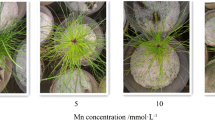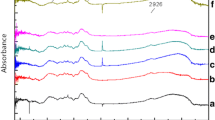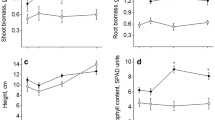Abstract
The cuttings of Populus cathayana were exposed to four different manganese (Mn) concentrations (0, 0.1, 0.5 and 1 mM) in a greenhouse to investigate the toxicity of Mn and the detoxifying responses of woody plants. Two contrasting populations of P. cathayana, which were from wet and dry climate regions in western China, respectively, were examined in our study. The results showed that high concentration of Mn caused significant decrease in shoot height, biomass accumulation, and leaf number and leaf areas. Injuries to the anatomical features of leaves were also found as the reduced thickness of palisade and spongy parenchyma, the decreased density in the conducting tissue and the collapse and split in the meristematic tissue in the central vein. Moreover, Mn treatments caused the accumulation of hydrogen peroxide (H2O2), and then resulted in oxidative stress indicated by the oxidation of proteins and DNA. Many physiological responses were employed to cope with the toxicity of Mn, including the increase in the contents of non-protein thiol (NP-SH), phytochelatins (PCs) and phenolics compounds and the stimulated activities of guaiacol peroxidase (GPX) and polyphenol oxidase (PPO) for the chelation of Mn and for the antioxidation of reactive oxygen species. The population from dry climate habitat showed a lower leaf concentration of Mn, higher contents of the chelators, and higher activities of GPX and PPO than did the wet climate population at the same Mn treatment, thereby possessing a superior Mn tolerance. In both populations, most of the Mn was accumulated in the shoot, which is favorable regarding phytoremediation.





Similar content being viewed by others
References
Ali MB, Singh N, Shohael AM, Hahn EJ, Paek KY (2006) Phenolics metabolism and lignin synthesis in root suspension cultures of Panax ginseng in response to copper stress. Plant Sci 171:147–154
Baker AJM, Brooks RR (1989) Terrestrial higher plants which hyperaccumulate metallic elements—a review of their distribution, ecology and phytochemistry. Biorecovery 1:81–126
Bonham-Smith PC, Kapoor M, Bewley JD (1987) Establishment of thermotolerance in maize by exposure to stresses other than a heat shock does not require heat shock protein synthesis. Plant Physiol 85:575–580
Bradford MM (1976) A rapid and sensitive method for quantification of microgram quantities of protein utilizing the principle of protein-dye binding. Anal Biochem 72:248–254
Brennan T, Frenkel C (1977) Involvement of hydrogen peroxide in the regulation of senescence in pear. Plant Physiol 59:411–416
Burken JG, Schnoor JL (1997) Uptake and metabolism of atrazine by poplar trees. Environ Sci Technol 31:1399–1406
Castiglione S, Wang G, Damiani G, Bandi C, Bisoffi S., Sala F (1993) RAPD fingerprints for identification and for taxonomic studies of elite poplar (Populus spp) clones. Theor Appl Genet 87:54–59
Collins G, Nie XL, Saltveit M (1995) Heat shock proteins and chilling sensitivity of mung bean hypocotyls. J Exp Bot 46:795–802
Cunningham SD, Berti WR, Huang JW (1995) Phytoremediation of contaminated soils. Trends Biotechnol 13:393–397
De Vos CHR, Vonk MJ, Vooijs R, Schat H (1992) Glutathione depletion due to copper-induced phytochelatin synthesis causes oxidative stress in Silene cucubalus. Plant Physiol 98:853–858
Di Baccio D, Tognetti R, Sebastiani L, Vitagliano C (2003) Responses of Populus deltoides × Populus nigra (Populus × euramericana) clone I-124 to high zinc concentrations. New Phytol 159:443–452
Ellman GL (1959) Tissue sulfhydryl groups. Arch Biochem Biophys 82:70–77
Ferrer AS, Bru R, Cabanes J, Carmona FG (1988) Characterization of catecholase and cresolase activities of monastrell grape polyphenol oxidase. Phytochemistry 27:319–321
Foy CD, Lee EH, Rowland R, Devine TE, Buzzell RI (1995) Ozone tolerance related to flavonol glycoside genes in soybean. J Plant Nutr 18:637–647
Gisbert C, Ros R, De Haro A, Walker DJ, Bernal MP, Serrano R, Navarro-Avino J (2003) A plant genetically modified that accumulates Pb is especially promising for Phytoremediation. Biochem Bioph Res Commun 303:440–445
Gullner G, Komives T, Rennenberg H (2001) Enhanced tolerance of transgenic poplar plants overexpressing gamma-glutamylcysteine synthetase towards chloroacetanilide herbicides. J Exp Bot 52:971–979
Hall JL (2002) Cellular mechanisms for heavy metal detoxification and tolerance. J Exp Bot 53:1–11
He Z, Li J, ZH H, Ma M (2005) Different effects of calcium and lanthanum on the expression of phytochelatin synthase gene and cadmium absorption in Lactuca sativa. Plant Sci 168:309–318
Hissin PJ, Hilf R (1976) A fluorometric method for determination of oxidized and reduced glutathione in tissues. Anal Biochem 74:214–226
Jordahl J, Foster L, Schnoor J, Alvarez PJ (1997) Effect of hybrid poplar trees on microbial populations important to hazardous waste bioremediation. Environ Toxicol Chem 16:1318–1321
Koprivova A, Kopriva S, Jager D, Will B, Jouanin L, Rennenberg H (2002) Evaluation of transgenic poplars over-expressing enzymes of glutathione synthesis for phytoremediation of cadmium. Plant Biol 4:664–670
Kuznetsov V, Rakutin V, Boisova N, Rotschupkin B (1993) Why does heat shock increase salt resistance in cotton plants? Plant Physiol Biochem 31:181–188
Lei Y, Yin C, Li C (2006) Differences in some morphological, physiological, and biochemical responses to drought stress in two contrasting populations of Populus przewalskii. Physiol Plant 127:182–191
Levine RL, Willians JA, Stadtman ER, Shacter E (1994) Carbonyl assays for determination of oxidatively modified proteins. Method Enzymol 233:346–363
Lin C, Kao C (2001) Cell wall peroxidase activity, hydrogen peroxide level and NaCl-inhibited root growth of rice seedlings. Plant Soil 230:135–143
Lin J, Wang G (2002) Doubled CO2 could improve the drought tolerance better in sensitive cultivars than in tolerant cultivars in spring wheat. Plant Sci 163:627–637
May MJ, Vernoux T, Sánchez-Fernández R, Van Montagu M, Inzé D (1998) Evidence for posttranscriptional activation of g-glutamylcysteine synthetase during plant stress response. Proc Natl Acad Sci 95:12049–12054
Metwally A, Safronova VI, Belimov AA, Dietz1 KJ (2005) Genotypic variation of the response to cadmium toxicity in Pisum sativum L. J Exp Bot 56:167–178
Mishra S, srivastava S, Tripathi RD, Govindarajan R, Kuriakose SV, Prasad MNV (2006) Phytochelatin synthesis and response of antioxidants during cadmium stress in Bacopa monnieri L. Plant Physiol Biochem 44:25–37
Moran JF, Becana M, Iturbe-Ormaetxe I, Frechilla S, Klucas RV, Aparicio-Tejo P (1994) Drought induces oxidative stress in pea plants. Planta 194:346–352
Newman LA, Strand SE, Choe N, Duffy J, Ekuan G, Ruszaj M, Shurtleff BB, Wilmoth J, Heilman P, Gordon MP (1997) Uptake and biotransformation of trichloroethylene by hybrid poplars. Environ Sci Technol 31:1062–1067
Orzech KA, Burke JJ (1988) Heat shock and the protection against metal toxicity in wheat leaves. Plant Cell Environ 11:711–714
Pastori GM, Foyer CH (2002) Common components, networks, and pathways of cross-tolerance to stress. The central role of “redox” and abscisic acid-mediated controls. Plant Physiol 129:460–468
Pilon-Smits E (2005) Phytoremediation. Annu Rev Plant Biol 56:15–39
Pittman JK (2005) Managing the manganese: molecular mechanisms of manganese transport and homeostasis. New Phytol 167:733–742
Pulford ID, Watson C (2003) Phytoremediation of heavy metal-contaminated land by trees-a review. Environ Int 29:529–540
Punshon T, Dickinson N (1997) Acclimation of Salix to metal stress. New Phytol 137:303–314
Rauser WE (1995) Phytochelatins and related peptides (Structure, Biosynthesis, and Function). Plant Physiol 109:1141–1149
Rice-Evans CA, Miller NJ, Paganga G (1997) Antioxidant properties of phenolic compounds. Trends Plant Sci 2:152–159
Robinson BH, Chiarucci A, Brooks RR, Petit D, Kirkman JH, Gregg PEH, De Dominicis V (1997) The nickel hyperaccumulator plant Alyssum bertolonii as a potential agent for phytoremediation and phytomining of nickel. J Geochem Explor 59:75–86
Romero-Puertas MC, Palma JM, Gόmez M, del Rio LA, Sandalio LM (2002) Cadmium causes the oxidative modification of proteins in pea plants. Plant Cell Environ 25:677–686
Salt DE, Smith RD, Raskin I (1998) Phytoremediation. Annu Rev Plant Physiol Plant Mol Biol 49:643–668
Shetty KK, Curtis OF, Levin RE, Withowsky R, Ang W (1995) Prevention of vitrification associated with in vitro shoot cultures of oregano (Origanum vulgare) by Pseudomona spp. J Plant Physiol 147:447–451
Shi Q, Zhu Z, Xu M, Qian Q, Yu J (2006) Effect of excess manganese on the antioxidant system in Cucumis satavus L. under two light intensities. Environ Exp Bot 58:197–205
Sinha P, Dube BK, Chatterjee C (2006) Manganese stress alters phytotoxic effects of chromium in green gram physiology (Vigna radiata L.) cv. PU 19. Environ Exp Bot 57:131–138
Smeets K, Cuypers A, Lambrechts A, Semane B, Hoet P, van Laere A, Vangronsveld J (2005) Induction of oxidative stress and antioxidative mechanisms in Phaseolus vulgaris after Cd application. Plant Physiol Biochem 43:437–444
Srivastava M, Ma LQ, Singh N, Singh S (2005) Antioxidant responses of hyper-accumulator and sensitive fern species to arsenic. J Exp Bot 56:1335–1342
Toppi SDL, Gabbrielli R (1999) Response to cadmium in higher plants. Envrion Exp Bot 41:105–130
Vartanian JP, Sala M, Henry M, Hobson SW, Meyerhans A (1999) Manganese cations increase the mutation rate of human immune deficiency virus type 1 ex vivo. J Gen Virol 80:1983–1986
Vogeli-Lange R, Wagner GJ (1990) Subcellular localization of cadmium and cadmium-binding peptides in tobacco leaf. Plant Physiol l92:1086–1093
Wang W, Xiao Y, Chen L, Lin P (2007) Leaf anatomical responses to periodical waterlogging in simulated semidiurnal tides in mangrove Bruguiera gymnorrhiza seedlings. Aquat Bot 86:223–228
Wu F, Chen F, Wei K, Zhang G (2004) Effect of cadmium on free amino acid, glutathione and ascorbic acid concentrations in two barley genotypes (Hordeum vulgare L.) differing in cadmium tolerance. Chemosphere 57:447–454
Xiang C, Oliver DJ (1998) Glutathione metabolic genes coordinately respond to heavy metals and jasmonic acid in Arabidopsis. Plant Cell 10:1539–1550
Xue S, Chen Y, Reeves RD, Baker AJM, Lin Q, Fernando DR (2004) Manganese uptake and accumulation by the hyperaccumulator plant Phytolacca acinosa Roxb. (Phytolaccaceae). Environ Pollut 131:393–399
Yin C, Peng Y, Zang R, Zhu Y, Li C (2005) Adaptive responses of Populus kangdingensis to drought stress. Physiol Plant 123:445–451
Zhang H, Xu W, Guo J, He Z, Ma M (2005) Coordinated responses of phytochelatins and metallothioneins to heavy metals in garlic seedlings. Plant Sci 169:1059–1065
Acknowledgments
The research was supported by the Outstanding Young Scientist Program of the National Natural Science Foundation of China (No. 30525036) and the China National Key Program of the International Cooperation for Science and Technology (No. 2005DFA30620).
Author information
Authors and Affiliations
Corresponding author
Additional information
Communicated by T. Hogetsu.
Rights and permissions
About this article
Cite this article
Lei, Y., Chen, K., Tian, X. et al. Effect of Mn toxicity on morphological and physiological changes in two Populus cathayana populations originating from different habitats. Trees 21, 569–580 (2007). https://doi.org/10.1007/s00468-007-0152-0
Received:
Revised:
Accepted:
Published:
Issue Date:
DOI: https://doi.org/10.1007/s00468-007-0152-0




